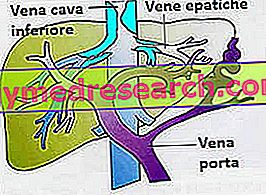Generality
Budd-Chiari syndrome is a rare set of signs and symptoms, triggered by total or partial occlusion of the hepatic veins. This occlusion can be caused by venous thrombosis or external compression, although it must be remembered that in half of the cases it is idiopathic.

Figure: the hepatic veins are blood vessels that drain the de-oxygenated blood from the liver, and pour it into the inferior vena cava. From the site: espondilitis.eu
The symptoms that characterize Budd-Chiari syndrome are different; the main ones are ascites, hepatomegaly, abdominal pain and jaundice. The symptomatology can have a sudden onset (acute form) or gradual (chronic form).
The diagnosis is based on an objective examination followed by a series of more specific checks, such as the CT scan or angiography.
The therapeutic treatment, which is used in most cases, is the TIPS, a surgical procedure for the construction of an artificial canal that eludes the venous block.
What is Budd-Chiari syndrome?
Budd-Chiari syndrome is a disease caused by partial or total occlusion of hepatic veins (blood vessels that drain and collect blood from the liver).
Occlusion can affect venous ducts of any size, from the smallest to the largest.
WHERE ARE THE HUMAN VEINS Gathered?
From the anatomical point of view, it is recalled that the hepatic veins flow into the inferior vena cava ; it is a large vessel responsible for collecting all the oxygen-poor blood from the subdiaphragmatic region of the body.
MAIN CONSEQUENCES OF THE BUDD-CHIARI SYNDROME
Because of hepatic venous occlusion, the blood cannot leave the liver, therefore it causes an enlargement of the organ ( hepatomegaly ). This also has another consequence: it increases blood pressure in the portal vein (the large venous vessel that collects blood from the intestine and transports it to the liver); this pathological process is called portal hypertension .
The establishment of a condition of portal hypertension has different effects:
- Causes abnormal dilatation of the submucosal veins of the esophagus ( esophageal varices )
- It damages the cells that make up the liver tissue
- It gives rise to ascites, which is a pathological collection of liquids in the abdominal cavity. The exact point where the liquid accumulates is between the two sheets that make up the peritoneum : this space is called the peritoneal cavity.
CLASSIFICATION OF THE BUDD-CHIARI SYNDROME
Budd-Chiari syndrome can be acute / fulminant (20% of cases) or chronic (80% of cases).
Epidemiology
Budd-Chiari syndrome is very rare; according to medical statistics, in fact, it affects one person every million individuals. He does not prefer a particular sex but is more common between the ages of 20 and 40.
Causes
In at least half of the cases, Budd-Chiari syndrome occurs without a precise cause ( idiopathic Budd-Chiari syndrome ).
When the causes are identifiable, the disease may instead depend on a thrombosis that affects the hepatic veins ( primary Budd-Chiari syndrome ) or an external compression of the same veins ( secondary Budd-Chiari syndrome ).
IDIOPATHICAL BUDD-CHIARI SYNDROME
In medicine, a disease is called idiopathic when it arises without an identifiable reason.
PRIMARY BUDD-CHIARI SYNDROME
Thrombosis is a pathological process characterized by the formation of one or more blood clots (called thrombi ), inside the blood vessels (we speak of venous thrombosis if it takes place in the veins, and of arterial thrombosis if it takes place in the arteries).
The presence of even a single thrombus can obstruct the lumen of the vessel and block the flow of blood downstream of the clot.
Thrombosis of hepatic veins may occur due to:
- Polycythemia vera
- Antiphospholipid syndrome
- A complicated pregnancy
- A genetic tendency to thrombosis, due to lack or defect of some fundamental elements of the coagulation process (protein C, protein S, factor V of Leiden, prothrombin, antithrombin etc.).
- Septicemia
- Sickle cell anemia
- Use of the contraceptive pill
- Paroxysmal nocturnal hemoglobinuria
- Lupus anticoagulant
SECONDARY BUDD-CHIAR SYNDROME
Secondary Budd-Chiari syndrome may arise due to:
- Phlebitis
- Autoimmune diseases such as Behçet's disease
- Tumors in organs or tissues adjacent to the liver (eg renal cell carcinoma, hepatocellular carcinoma or adrenal carcinoma)
- traumas
- Presence, at birth, of a species of membrane (membranous obliteration) that blocks the inferior vena cava. This anomaly is particularly widespread in Asia and in some African states (for example South Africa).
- leiomyosarcoma
Symptoms and Complications
The classic symptoms and signs of Budd-Chiari syndrome are abdominal pain, ascites, jaundice and hepatomegaly .
In some cases, patients may also have a high level of liver enzymes, splenomegaly (enlarged spleen), vomiting, haematemesis (vomiting with blood), hepatic encephalopathy, edema of the legs and diarrhea.
CHARACTERISTICS OF ACUTE AND CHRONIC FORMS
The acute form of Budd-Chiari syndrome is characterized by intense and rapid and sudden appearance symptoms.
In some situations it is so severe that within a few hours or days it can lead to death, due to the onset of a condition of shock and hepatic coma (acute fulminant form).
Most common symptoms of acute form- Abdominal pain
- Hepatomegaly
- Vomiting and hematemesis
- Jaundice
- splenomegaly
- Diarrhea
- Ascites
- Abdominal pain
- Ascites
- Hepatomegaly

Figure: Ascites. The collection of fluids that occurs during ascites swells the abdomen very clearly. From the site: dynamic.psu.ac.th
The chronic form, on the other hand, has a gradual beginning and a slow progression. Sometimes, some patients remain asymptomatic (ie not showing symptoms) for several consecutive years.
COMPLICATIONS
In some subjects, Budd-Chiari syndrome may lead to liver cirrhosis, ie the replacement of liver cells with scar-free scar tissue.
Due to liver cirrhosis, a condition of liver failure is established, which is incompatible with a normal life.
Diagnosis
The signs that lead a doctor to suspect Budd-Chiari syndrome are hepatomegaly, ascites and high levels of liver enzymes, detected in blood tests.
However, to resolve any doubts and discover the causes that caused the suspicious signs and symptoms, the following diagnostic tests must be performed:
- ecodoppler
- Nuclear magnetic resonance (RMN)
- CT scan (computerized axial tomography)
- Liver biopsy. It is also important to rule out similar pathologies (differential diagnosis), such as galactosemia and Reye's syndrome
- Angiography
Treatment
The therapy varies depending on the causes and the associated symptoms (type of symptoms, speed of appearance of disorders, degree of intensity etc.).
Patients with ascites and leg edema are prescribed diuretic drugs and a low salt diet .
For patients with thrombosis in the hepatic veins, a treatment with thrombolytic drugs (for example heparin) could be prescribed.

Figure: CT scan of an individual with Budd-Chiari syndrome. Arrows indicate venous occlusions. From the site: wikipedia.org
In almost all patients, surgery, known as TIPS, is necessary for the construction of an alternative passage to venous blood flow.
An alternative to the TIPS is represented by the angioplasty operation, with which the blood vessel (or blood vessels, if they are more than one) is narrowed or completely obstructed.
TIPS
The TIPS, or Transgugular Intrahepatic Portosystemic Shunt, involves the creation of an artificial channel (called shunt ), which connects the portal vein with the hepatic vein; in this way it is possible to bypass the vessel obstruction.
The realization of the shunt, whose component material is introduced through the jugular, is a very complex procedure, which requires the use of a precise X-ray guide.
Risks of TIPS intervention: TIPS can give rise (or worsen) to hepatic encephalopathy.
WHAT TO DO IN THE CASE OF HEPATIC CIRRHOSIS?
In cases of liver cirrhosis, the most indicated treatment would be a liver transplant, a very delicate surgical operation that is not without possible complications.
Prognosis
Budd-Chiari syndrome tends to have a negative prognosis.
The possibilities of healing, in fact, are few and are further reduced if the triggering causes are serious or if the therapy is late (ie begins when the liver is already partially damaged).
According to some statistical research, thanks to appropriate treatments 2/3 of individuals with Budd-Chiari syndrome live for about 10 years from the time of diagnosis.



